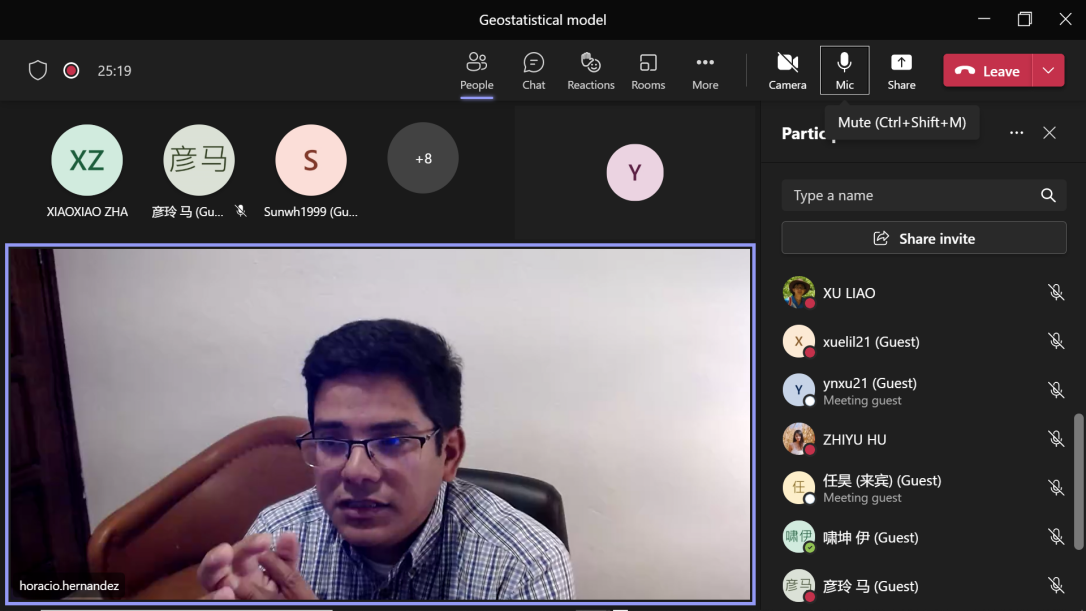A series of 20 online lectures themed on “Geostatistical Model and its Application in the Groundwater Resource Evaluation” was given by Professor Horacio Hernandez from the Department of Geomatics and Hydraulic Engineering, University of Guanajuato (Mexico), invited by Prof. Bian Jianmin from the College of New Energy and Environment, Jilin University (CNEE), aiming at strengthening the internationalization of postgraduate courses, improving the quality of postgraduate teaching, equipping students with more technical means in the sustainable development of water resources, enhancing their global competence, and promoting the construction of first-class academic disciplines in the College.
Prof. Horacio Hernandez received his master’s degree in Water Engineering from the University of La Coruña (Spain) in October 2008 and his Ph.D. in Civil Engineering from the University of La Coruña (Spain) in July 2011. He has long been studying groundwater-surface water interaction and groundwater modelling, and has unique insights into the water cycle, water balance, and water resources evaluation.
Guanajuato is a water-scarce region in Mexico. The lack of data on local stratigraphic structures, water replenishment and water use makes it difficult to obtain an accurate picture of available water resources in the region. Since entering the University of Guanajuato in December 2012, Prof. Horacio Hernandez has developed a number of tools on his own by combing ArcMAP Empirical Bayesian Kriging (EBK) method with USGS Curve Fit, opening up a new horizon for groundwater resource evaluation and laying a solid foundation for comprehensive water resources use in the region. These significant achievements made Prof. Horacio a pivotal figure in this field. The EBK geostatistical model applied and developed by him is widely applicable to the study of water resources in aquifers in third-world countries where there is little information on geology and environment other than water level. The model can also verify and complement 3D water flow models in areas with sufficient available data.
Prof. Horacio began his lectures by introducing the fundamentals of the application of geostatistical modelling, analyzing the advantages and disadvantages of EBK versus the traditional Kriging method, and providing a step-by-step introduction to ArcMAP tools. He also digitized conceptual models with Darcy’s Law and Water Balance Theory, and produced a number of graphs that could be easily understood by the students. First, through the model, four risk levels of water resources (accelerating replenishment, decelerating replenishment, decelerating drop, and accelerating drop of water level) can be identified by combining the drop rate and acceleration in water level. This innovative research enables a clear picture of the water resources as to whether there are unregistered wells or water extractions in excess of the permitted value in the area under study. Second, the combination of water level drop with regional storage coefficients was used to form a graph of temporal water storage changes. This makes it easier for researchers to focus on changes in water storage in key areas so that water use strategies can be adjusted accordingly and timely. Third, it is convenient to carry out separate water balance calculations for specific areas under focus. After an introduction to fundamentals and theories and guided practices, Prof. Horacio introduced and represented his self-developed automation tools, which proved to significantly accelerate calculations. The more and longer the input data, the more obvious the advantages of such automation tools. The development of the 2D and 3D modules of the model has almost been completed. Demonstrations of the modules were presented in the lectures. Finally, Prof. Horacio applied the USGS Curve Fit tool to carry out model predictions and grid-level analysis of water resources trends under the circumstances that there is no substantial change in national policy and climate conditions in the coming few years. This makes it possible to conduct predictions on water resources even if monitoring wells are discontinuously distributed in both space and time. The lectures combine traditional hydrological and hydrogeological theories with emerging models and tools to shed light on modelling, simulation, and prediction in the absence of data, and achieve a more efficient and accurate description of water resources development in aquifers with the help of scientific methods.
The lectures concluded with Prof. Horacio delivering a detailed presentation on the application of geostatistical models to various aquifers in Guanajuato. Students discussed the possibilities of applying geostatistical models to their own postgraduate research projects, as well as the data needed and the methods to obtain them. Students all benefited from having their theoretical and practical knowledge enhanced, and from understanding how to analyze and operate various cases. They have also learned a lot from Prof. Horacio in terms of model error analysis and rigorous attitude toward research.
The lectures have deepened students’ basic understanding and knowledge of groundwater, and clarified the innovative applications of geostatistical models in water resources analysis. Prof. Horacio’s detailed lectures have helped students acquire various tools and methods for regional analysis and model applications. The case studies presented by Prof. Horacio on the applications of the model considering different climates and geographical conditions improved students’ practical abilities and broadened their horizons.


Live lectures delivered by Prof. Horacio Hernandez